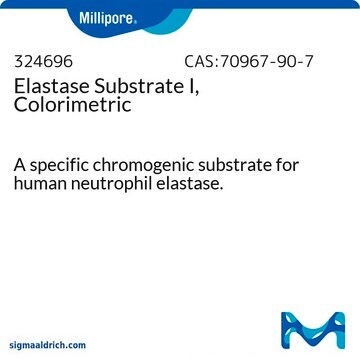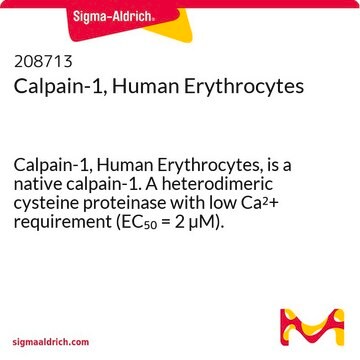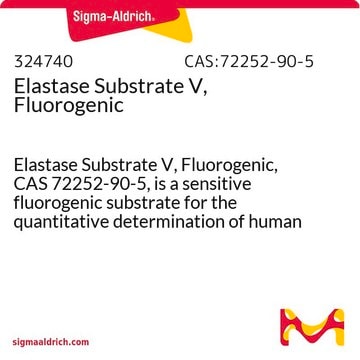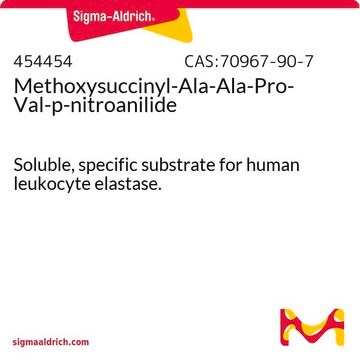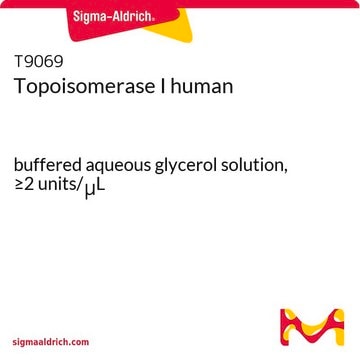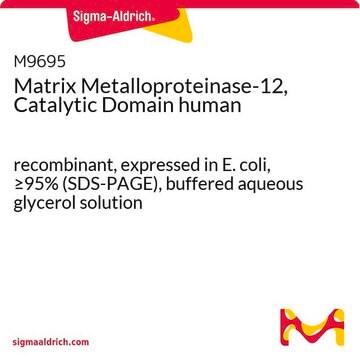This form of neutrophil elastase is a salt-free preparation and is supplied in an active form with a specific activity of ≥20 units/mg protein. It is not sterile and has not been tested for cell culture applications. To use it in a cell culture assay, sterile filtration is necessary, which may result in some product retention on the filter.
324681
Elastase, menschliches Neutrophil
Elastase, Human Neutrophil, CAS 9004-06-2, is a serine protease that degrades elastin, collagen, and proteoglycans
Synonym(e):
Elastase, menschliches Neutrophil
Größe auswählen
Größe auswählen
About This Item
Empfohlene Produkte
Qualitätsniveau
Beschreibung
Merck USA index - 14, 3535
Form
lyophilized solid
Spezifische Aktivität
≥20 units/mg protein
Hersteller/Markenname
Calbiochem®
Lagerbedingungen
OK to freeze
Versandbedingung
ambient
Lagertemp.
−20°C
Allgemeine Beschreibung
Warnhinweis
Einheitendefinition
Physikalische Form
Angaben zur Herstellung
Rekonstituierung
Hinweis zur Analyse
Sonstige Hinweise
Junger, W.G., et al. 1992. Biol. Chem. Hoppe-Seyler 373, 691.
Selak, M.A. 1992. Thromb. Haemost.68, 570.
Baugh, R.J., and Travis, J. 1976. Biochemistry15, 836.
Rechtliche Hinweise
Signalwort
Danger
H-Sätze
Gefahreneinstufungen
Eye Irrit. 2 - Resp. Sens. 1 - Skin Irrit. 2 - STOT SE 3
Zielorgane
Respiratory system
Lagerklassenschlüssel
11 - Combustible Solids
WGK
WGK 3
Flammpunkt (°F)
Not applicable
Flammpunkt (°C)
Not applicable
Analysenzertifikate (COA)
Suchen Sie nach Analysenzertifikate (COA), indem Sie die Lot-/Chargennummer des Produkts eingeben. Lot- und Chargennummern sind auf dem Produktetikett hinter den Wörtern ‘Lot’ oder ‘Batch’ (Lot oder Charge) zu finden.
Besitzen Sie dieses Produkt bereits?
In der Dokumentenbibliothek finden Sie die Dokumentation zu den Produkten, die Sie kürzlich erworben haben.
Kunden haben sich ebenfalls angesehen
-
Hi Is this form of neutrophil elastase active and suitable be used directly in a cell assay? And is it sterile ? Mvh Magdalena
1 answer-
Helpful?
-
-
Has this product been tested for the presence of endotoxin?
1 answer-
Unfortunately, this product has not been tested for the presence for endotoxins
Helpful?
-
-
what is the molecular wight of the enzyme ?
1 answer-
Unfortunately, the molecular weight has not been determined for this product. A number of estimates have been reported in the literature. Please see the link below to a publication that may be helpful:
https://www.sciencedirect.com/science/article/pii/S1016847823175091?via%3DihubHelpful?
-
-
Is this the active form of the enzyme? or does it require activation by cathepsin?
1 answer-
Here are the recommended reconstitution and reaction conditions:
Solubility information:
Reconstitute in 50 mM sodium acetate, pH 5.5, with 200 mM NaCl or in other aqueous buffers. Material is most active near a neutral pH, but to maintain stability upon reconstitution, use in a slightly acidic buffer (pH 5.5) to avoid autolysis.
Following reconstitution, aliquot and freeze (-20°C) for long term storage or refrigerate (4°C) for short-term storage. Acidic stock solutions are stable for up to 1 month at 4°C or for up to 1 year at -20°C.Human Neutrophil Elastase Protocol
1. Dissolve enzyme in reaction buffer: 100 mM Tris-HCl, pH 7.5, 500 mM NaCl.
2. Prepare the substrate stock solution by dissolving Elastase Substrate I (MeOSuc-Ala-Ala-Pro-Val-pNA, Cat. No. 324696) at 50 mM in DMSO.
3. Just prior to assay, dilute the substrate stock solution with an equal volume of 200 mM Tris-HCl, pH 8.0. Mix well.
4. Prepare the assay mixture by combining 960 µl of reaction buffer with 40 µl of diluted substrate stock solution.
5. Add enzyme to assay mixture, mix, and incubate at 25°C.
6. Monitor the change in absorbance at 410 nm. Use an ε of 8800 at 410 nm to calculate the hydrolysis of nitroanilide.Helpful?
-
Active Filters
Unser Team von Wissenschaftlern verfügt über Erfahrung in allen Forschungsbereichen einschließlich Life Science, Materialwissenschaften, chemischer Synthese, Chromatographie, Analytik und vielen mehr..
Setzen Sie sich mit dem technischen Dienst in Verbindung.
